Repair Topics
How To Unblock a Toilet
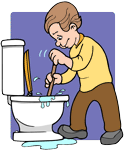 Why would you need to know how to unclog a toilet? Just about every home in the United States has at least one toilet. Many homes have several. From time to time these toilets will clog. When they do it can be a problem. If you are not careful you can get a lot of dirty water all over the floor. What do you do?
Why would you need to know how to unclog a toilet? Just about every home in the United States has at least one toilet. Many homes have several. From time to time these toilets will clog. When they do it can be a problem. If you are not careful you can get a lot of dirty water all over the floor. What do you do?
Not sure if this is your problem? See the articles 'Troubleshooting Toilet Problems' and 'Plumbing Repairs for Homeowners' for a listing of related topics.
New government standards require that toilets use a maximum of 1.6 gallons per flush. That is not a lot of water. Just a few decades ago, toilets used as much as 7 gallons of water per flush. The advantage to this is you save on your water bills. The down side is that not all toilets flush well with that small amount of water.
Do you really need to call a plumber? Usually not. Instead you can learn how to unclog a toilet and solve the problem yourself. Most of the time a plunger can take care of this problem in less than five minutes (clean up, if any, included).
How To Unclog a Toilet - Information
What Can You Save?
A plumber can usually unclog a toilet in a few minutes. You will still have to pay for the service call which will run $50 to $100. Would you take that much for five minutes work?
How Hard Could It Be?
Learning how to unclog a toilet is a fairly simple process.
Check the Simple Things!
Using a plunger is about the simplest thing. A toilet auger is only slightly more difficult.
What Can Go Wrong?
You can wind up with a lot of dirty water on the floor. This can happen if you flush the toilet a second or third time when it is clogged. Plunging a toilet will also generate some splashing. Clear everything out of the area that can be damaged by water. Have some rags handy. You might want to put on some old clothes. Remember, this is dirty water, try to control it.
How to Unclog a Toilet – The Steps Involved
Not much to troubleshoot. The water in the toilet doesn't go down, the toilet is clogged. You need to learn how to unclog a toilet to fix this problem. Usually you never know the reason. Sometimes it is too much volume. Other times something gets caught in the trap.
Before you get started you want to make sure you don't have a more serious drainage problem. Make sure that water is not backing up into another drain, such as the shower or tub, a lower drain. If you have water backing up in multiple drains you have a sewer line problem and not a toilet problem. It may take a professional assessment to determine if the main sewer line is clogged. Check the article 'How to Unclog a Drain', for information on tracking down your problem.
Preparation
 When you learn how to unclog a toilet you want to remember you are dealing with water. Remove everything from the area that could be damaged by dirty water. Some water will probably splash, move anything you don't want ruined.
When you learn how to unclog a toilet you want to remember you are dealing with water. Remove everything from the area that could be damaged by dirty water. Some water will probably splash, move anything you don't want ruined.
Have a mop and rags nearby, just in case. If the water level is up near the rim, you may need to get a small pail and bail some of the water out. A plunger will displace water when it is used. In addition plunging will agitate the water. A high water level will cause splashing and spillover.
Newer toilets do not use much water. You may get away with flushing the toilet a second time. This sometimes can work in your favor, the extra water pressure may force the clog out. The danger is adding more water to a clogged toilet. The higher the water the greater the danger of a spill.
Avoiding toilet clogs makes good sense, especially if you have just got done with cleaning up after one. The old saying goes, 'an ounce of prevention is worth a pound of cure', is apt when it comes to toilets. A toilet that does not get clogged is one less problem in your life.
Do you have a problem with your toilet right now? See the article 'Troubleshooting Toilets' to track down your problem. Want to avoid problems in the future? See the information below.
Make Sure the Toilet is Flushing Properly
Toilets are designed to use a certain amount of water to flush. In the last few decades that amount has been reduced to less than two gallons of water. Toilets have been engineered to work with that amount of water. However, if the amount of water is less than expected, problems will arise.
The first thing you want to do is make sure that you have the proper amount of water in the tank. All toilets have some sort of floatation device that controls the amount of water that is kept in the tank. The water level is controlled by adjusting the float. See the article 'Adjusting the Toilet Tank Water Level' for more information.
The Flapper Needs to Work Correctly
The toilet flapper is part of the toilet flush valve. The flapper is pulled up when you press down on the toilet handle. When it works properly, the flapper closes after the proper amount of water has been released from the tank.
Sometimes the flapper closes too soon and not enough water is released. When this happens the flapper may need to be adjusted or replaced. For a complete discussion on repairing toilet flappers, see the article 'Toilet Flapper Repair'.
Flushing the Toilet Twice
Might sound a little silly, since the toilets are engineered to flush once with a certain amount of water. That is true, but when you have a large volume of material to flush, some extra water can help. Whenever there is a lot of, well, material in the basin and the toilet seems to struggle flushing it, an extra flush can help wash every thing away.
Solids that are not completely washed away can be the beginning of a future clog. This is true of both the toilet itself and the drains that go into the main sewer. Extra water can help to rinse out the toilet and the sewer lines.
Flushing the Right Material
Toilets are designed to deal with human waste. A nasty subject and a dirty job, but toilets are up for the task. However, toilets are not a disposal facility for everything in our homes that we want to get rid of. Certain materials will have a tendency to clog a toilet.
Toilet paper is designed to be flushed down a toilet. The paper breaks down when it is soaked with water and will flow through drains properly. Good practice would dictate that only toilet paper be flushed down the toilet.
Things You Should Not Flush Down the Toilet
It would be impossible to develop a list of things that you should not flush down the toilet. Common sense tells us that there are some common items that we should throw in the trash instead.
The main problem is that, not all paper and non-woven cloths breakdown in a sewer system. Have you ever watched a commercial for a paper towel that absorbs a lot of water, yet does not tear? Well, that paper towel is a good candidate for clogging your toilet or sewer system.
The following is a list of common items that should not be flushed down a toilet:
- Paper Towels
- Disinfectant Wipes
- Sanitary Napkins
- Tampons
- Disposable Diapers
- Cloth or Rags of Any Kind
- Plastic Bags
- Latex Gloves
Items on this list and similar items should be disposed of in another manner. Expensive toilet and sewer problems can result from not following this advice.
Troubleshooting Toilet Clogs
There is no guarantee that toilet clogs can be completely avoided. It does make sense that using some 'best practices' with your toilet will minimize the potential for clogs. If you follow the above suggestions it is likely that clogged toilets will not be a frequent occurrence in your life.
The article 'Troubleshooting Toilet Clogs' helped you to identify your problem and choose the best course of action. You also learned that sometimes the toilet can appear clogged, when you have a more serious sewer problem.
'Removing a Toilet Clog With aPlunger' is the simplest way to eliminate this problem. Plungers will work for the clogged toilets the majority of the time. Most homes have one and it only takes a few minutes.
When something is blocking the toilet, you may need to bring in the heavy artillery. A toilet auger will dislodge items that are caught in the trap. The article 'Using an Auger to Unclog a Toilet' covered the important information.
The article 'Removing a Toilet to Find a Clog' discussed the option of removing the toilet to deal with a clog. This should be viewed as a last ditch effort, when all other options have been tried.
Summary
I am hoping that your ordeal with a toilet clog did not involve removing the toilet. Usually you can solve the problem with a lot less effort. Toilet clogs are a common problem. The plunger is not called the 'plumber's helper' for nothing. Have one handy for future problems.
It is a wonderful feeling when you can make a repair and see such obvious results. When the toilet flushes without incident it means that no one will be bothering you about it. You can sleep at night knowing that no matter when the toilet gets used, it will work.
How To Use a Drain Snake
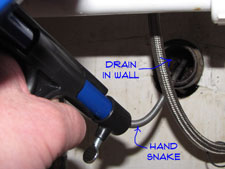 Using a snake on drains is what most people think of for this type of problem. Snakes are made of coiled spring steel the allows them to twist and turn through a drain line. They have an end on them the will give the clog a good jab. Electric snakes range in size from a small drill mounted unit to very large main sewer line snakes.
Using a snake on drains is what most people think of for this type of problem. Snakes are made of coiled spring steel the allows them to twist and turn through a drain line. They have an end on them the will give the clog a good jab. Electric snakes range in size from a small drill mounted unit to very large main sewer line snakes.
For related information see 'Troubleshooting Drain Problems' and 'How To Clean a Drain'.
Size matters with snakes. A twenty five foot snake that works for you bathroom sink will be woefully deficient for a main sewer line. Distance is an issue. How far is your drain from the main sewer line. You need a long enough snake to reach that distance.
Another big problem with a snake are traps. Look below your sink. Do you see the "P" or "J" shaped piece of pipe? That is there to keep sewer gases from getting into the home. The trap always has water in it to stop the gases.
A floor drain, shower drain and bathtub drains all have traps that are hidden from view. Using a snake on drains with traps is harder. Hard, not impossible. Be aware that the resistance you get a few feet in is likely the trap and not the clog. Unless of course the clog is in the trap, which is common.
The article on 'Unclogging Kitchen Sink Drains' will give you better instructions on using a small snake. For a use of a snake on a bathtub, see 'Unclogging a Bathtub Drain' for more information. That will leave us with floor drains and shower drains as likely candidates for a snake. You are likely going to need an electric snake for these drains. If you have a hand snake, try it first. Apply pressure and turn the snake to get through the trap.
WARNING!! Electric Snakes Can Be Dangerous!!! Keep Control of the Snake at All Times!!!
When you use an electric snake you have keep the unit as close to the drain as possible. Hold the snake with rubber gloves and keep it straight as it turns. Apply pressure and let it work through the trap. Do not allow the snake to form a loop, it can double back on itself and twist up. Fingers that get caught in this will not do well. They can even be broken. Not to mention it can ruin the snake.
When the clog breaks free you want to keep going with the snake. Run it back and forth through the problem spot. In addition run some water down the drain while the snake is running. This will wash the debris away and help to clean the snake. Yes, this is dirty water. Learning how to unclog a drain with a snake is a little tougher. Hopefully you have gotten through it ok.
Using Water Pressure on Drains
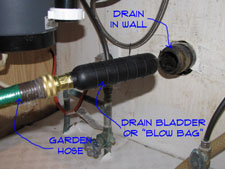 Using water pressure on drains sounds funny, but it can work. Yes you can, but you may need to get some special tooling. A tool called a drain bladder can be attached to a hose to clean out a drain.
Using water pressure on drains sounds funny, but it can work. Yes you can, but you may need to get some special tooling. A tool called a drain bladder can be attached to a hose to clean out a drain.
For related information, see the articles 'How To Clean a Drain', 'Using a Snake on a Drain' and 'Troubleshooting Plumbing Pipes'.
Water Pressure Cautions
You need to use some caution when using pressure on a drain. A big concern with using water pressure is that you are introducing more water into the drain. If the drain does not open up, you could have a bigger mess on your hands.
Do not try to use pressure on the compression fittings under your sinks. You could blow them apart and make bigger mess. The same rules apply for putting pressure on a line as do a plunger. You will need to close off any other drains that are on the clogged side of the blockage.
A blow bag is a simple device that fits into the drain and expands when you attach a garden hose to it. The water pressure builds up inside the pipe and the clog breaks free and is washed away. When it works properly, this method can be less messy than a snake. Unfortunately, it does not work for all types of clogs. Tree roots would be an example. Pressure will not remove them.
Using a Drain Bladder
Insert the blow bag with a garden hose attached to it, into the pipe in question. Turn the water on and wait for the bag to expand. Remember, you are introducing more water into this situation. Make sure you have stopped up any other drains connected to this line. If you don't the water will just come out there.
Not much else to do, just give it some time. You should be able to hear the water running freely in the line when the clog has been removed. Using water pressure on drains is not hard, but it can be messy.
Water Rams
Another pressure device is a water ram. This is not a common item in most homes. Think of it as a plunger on steroids. It sends a blast of air into the pipe that is hopefully strong enough to break up the clog. This method can work for clogs that are too difficult for a plunger.
Caution on the use of pressure is warranted with this device. The pressure will blow out at the weakest point. This could be the fittings on another sink or a corroded section of pipe in your basement.
A water ram will cost hundreds of dollars to purchase. Not normal homeowner fare. You may be able to rent one locally if you want to try this route. Get some instructions for its use if you do.
Summary
Using water pressure can be an effective way to clean a drain. The added water can help to wash all of the blockage down the drain. This method is not used as much as other methods and can sometimes cause additional problems.
If you were not successful in unclogging your drain, see the articles 'How To Clean a Drain', 'Using a Snake on a Drain' and 'Troubleshooting Plumbing Pipes'.
How To Use a Plunger
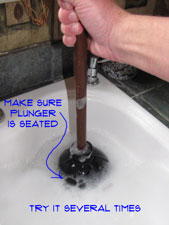 Do you know how to unclog a drain using a plunger? It is pretty easy. Plungers need to be able to seat and generate pressure on the clog. In some situations there are places the pressure can lost. A double bowl sink or a bathtub drain would be examples. When using a plunger you need to stop up any openings the might allow the pressure to vent. Put the stopper in the other sink or use a rag to close off the bathtub overflow.
Do you know how to unclog a drain using a plunger? It is pretty easy. Plungers need to be able to seat and generate pressure on the clog. In some situations there are places the pressure can lost. A double bowl sink or a bathtub drain would be examples. When using a plunger you need to stop up any openings the might allow the pressure to vent. Put the stopper in the other sink or use a rag to close off the bathtub overflow.
Make sure there is enough water to cover the plunger. You want the plunger to seat over the drain. Is there another opening that needs blocked off? Hold the stopper or a rag in place or have someone else hold it. Plunge vigorously several times.
Check to see if the water is draining down. Careful, don't run too much water until you are sure it is draining. Still clogged? Double check to make sure you are seated around the drain. Block off any other openings. You can usually tell when another drain is connected, by the venting or bubbling of the water. Try again, sometimes it takes several tries.
Hopefully the clog has broken free and the water is draining down. You tried several times and it is stilled clogged? You will have to take more drastic action. See the steps below. Congratulations if your drain is working. Learning how to unclog a drain has been a rewarding experience.
Kitchen Sinks
Kitchen sinks usually have two bowls. This makes plunging a kitchen sink little problematic. The extra pipe and the second sink tend to diffuse the pressure the plunger develops. It will still work for some clogs, but it is less effective on tougher ones.
A plunger needs to develop pressure to work. If you plunge one side of a kitchen sink the pressure pushes out the other drain and the clog is unaffected. You have to hold the stopper in place on the other side. The better you stop up the other sink, the better your chances are.
Make sure there is enough water to cover the plunger. Hold the stopper in place or have someone else hold it. Make sure the plunger is seated firmly around the drain. Plunge vigorously several times. Hopefully the clog has broken free and the water is draining down. If you answered yes you have successfully dealt with a clogged kitchen sink drain.
Still clogged? Check and see if you have the other sink sealed good. Make sure the plunger is seated firmly on the flange. Give it one more try. Still no good? You will need to bring in the big guns, read on.
How To Clean a Drain
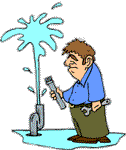 Have you learned how to unclog a drain? Like most homes you probably have several drains in your home. Dirty water from the sink or washing machine runs down them and life is good. Life is not good when the drain does not work. The dirty water backs up and makes a mess. Unclogging a drain is something you can do. A little messy, brace yourself, you can survive.
Have you learned how to unclog a drain? Like most homes you probably have several drains in your home. Dirty water from the sink or washing machine runs down them and life is good. Life is not good when the drain does not work. The dirty water backs up and makes a mess. Unclogging a drain is something you can do. A little messy, brace yourself, you can survive.
What can you do to deal with a clogged drain? Get rid of the clog is the obvious course of action. To sum it up loosely you have four courses of action to follow. Depending on the situation some are better than others.
To learn how to unclog a drain you first need to determine which drain is clogged. After that you can assemble the troops and go over a battle plan. The information below will help you decide how to attack the problem. Divide and conquer, heavy artillery, set up a spy network, read on.
How To Unclog a Drain - Information
What Can You Save?
Clogged drains can vary considerably in cost. Could be as little as $50 on up to several hundred dollars. A main sewer line is probably best left to the pros unless you feel like tackling a big dirty job. On average you can probably save a $100 by taking care of a clog yourself. Many times it will only take ten minutes. Hundred bucks, ten minutes? I see the wheels turning.
How Hard Could It Be?
You can get into some work learning how to unclog a drain. Most of the time it is not to difficult.
Check the Simple Things!
For minor clogs a plunger is king. It puts pressure on the clog and will force it to break up.
What Can Go Wrong?
A clogged drain means water, dirty water. Water can back up and damage things. The first thing to do with a clogged drain is stop using the water until you solve the problem. Have pails, mops and rags at the ready to clean up. Protect things in the area or move them.
Troubleshooting Clogged Drain Problems
Learning how to unclog a drain will involve three courses of action. These get harder and more complex with different drain problems. Using caustic chemicals to clean drains is not discussed. I do not believe they work that well, they are dangerous and they are bad for the environment.
Before you start try to determine what the problem is. When you run the sink or flush the toilet, does it come up in the bathtub? Are you getting nasty water with toilet paper in it, coming out of a floor drain? When multiple drains are affected it is often a main line that is clogged. Snaking out a floor drain if the main sewer line is clogged will do little good.
The article 'Using a Plunger' covered the best methods for this common household device. This article discusses how to use a 'plumbers helper' on a drain.
Another way to clean a drain is by using water pressure. This method can be messy, but effective. The article 'Using Water Pressure on a Drain' gives you some tips.
Cleaning drains with a plumbing snake is the first choice of many. Again, this can be a messy solution that requires some preparation. The article 'Using Snakes on Drains' discussed this topic. Follow this link to review it.
Summary
Drains are one of those things that you really don't notice until they don't work. When they don't work they can make quite a mess. Have you learned how to unclog a drain? Did the plunger work? If it did, you scored on that one.
Did you have to take drastic action and use a snake. Actually, a snake is a wonderful thing, it just sort of slithers and gets the job done. Wow, you want to put that one in your memoirs. Now that you have finished with this task you can move on to other repair projects.


